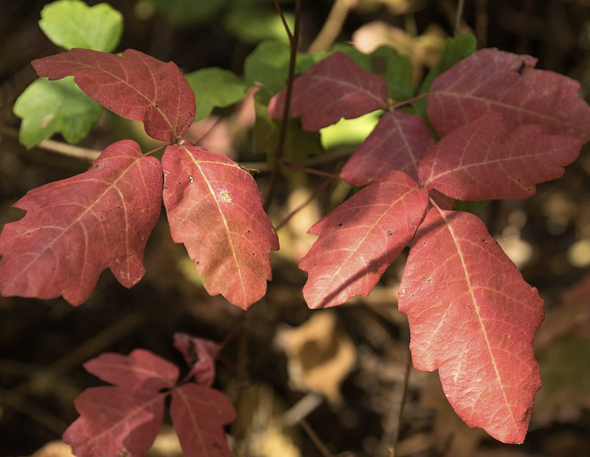Tuleyome's Science Corner - Poison Oak

Poison oak (Toxicodendron diversilobum) with fall foliage by Frank Schulenberg
I had my first encounter with poison oak when I was working in a research lab at UC Davis. I had just taken off my gloves after doing an experiment, when I noticed blisters across the back of my hand. Had I spilled acid on my hand? I frantically checked my gloves and work area – no sign of a spill or damage to the gloves. Then I remembered that I had gone hiking near Lake Berryessa a few days earlier. A Google image search confirmed my suspicions – the rash was caused by western poison oak.
Western poison oak is not an oak at all, but is actually a member of the cashew family, which includes cashews, mangos, and sumac. Its closest relatives are the other members of the genus Toxicodendron (Latin for “poison tree”), which includes eastern poison oak, poison ivy, and the Chinese lacquer tree. Western poison oak is the only member of the genus present in California, where it can be found throughout the Coast Ranges, in the Klamath, and at lower elevations in the Sierra Nevada.
Western poison oak takes both its common and species name (Toxicodendron diversilobum) from its lobed leaflets, which resemble oak leaves, except that they typically occur in clusters of three, while true oak leaves are singular. It can occur as either a shrub or a climbing vine and can have quite a bit of variability in the shape of individual leaflets. The key identifying feature is its compound leaves, which each have three leaflets, with the center leaflet having a longer stem. These leaflets begin the year with a green color that will change to red in the fall. The leaves are lost for the winter, during which time the plant can be identified by its reddish-brown stems. It’s important to note that all parts of the plant can cause a rash, so you’ll want to be careful even in the wintertime when it is leafless.
Poison oak and its relatives produce an oil called urushiol, which is rapidly absorbed into our skin upon contact. Once inside our skin, urushiol binds to a protein called CD1a. This causes CD1a to be recognized by the immune system as foreign, leading the immune system to attack the skin cells, eventually causing a blistery rash. Interestingly, CD1a has also been shown to play a key role in causing psoriasis.
Despite the headaches it causes for humans, poison oak is an important component of the ecosystem of the inner coast range, where its leaves provide forage for deer and its berries provide food for a variety of birds. This raises the question of how these animals can contact and consume poison oak without developing rashes like we do. While this question has yet to be definitely answered, the recent discovery CD1a’s role in causing the human reaction to urushiol provides an important clue – the CD1a gene is primarily only found in humans and other primates, suggesting that its absence may contribute to other animal’s lack of sensitivity to urushiol. This is supported by a 2016 study which showed that mice that were genetically engineered to have the CD1a gene became susceptible to urushiol.
Given that there’s not an obvious evolutionary benefit for primates to produce such a strong response to poison oak, you may be wondering “why us?” The answer is unknown, but I suspect that primate sensitivity to urushiol may be an unfortunate evolutionary accident – CD1a likely evolved to recognize other substances similar to urushiol, such as compounds produced by infectious bacteria or fungi, and therefore triggers a defense response when urushiol is present. The good news is that with a better understanding of how the human body reacts to poison oak, scientists may be able to develop more effective treatments. In the meantime, it’s best to keep an eye on your surroundings and remember the mantra “leaves of three, let it be.”
-Dr. Geoff Benn (gbenn@tuleyome.org)
Education Associate
RECENT ARTICLES






